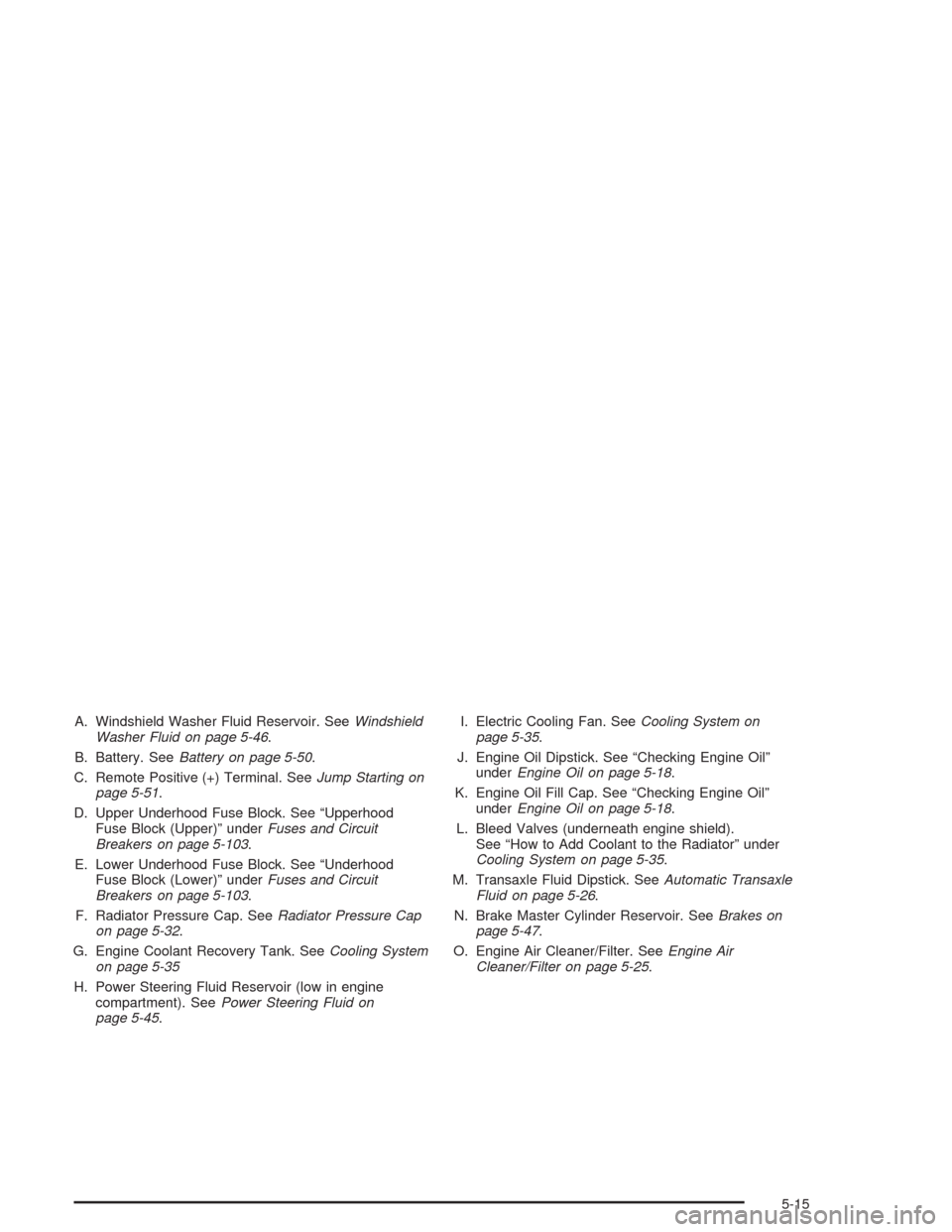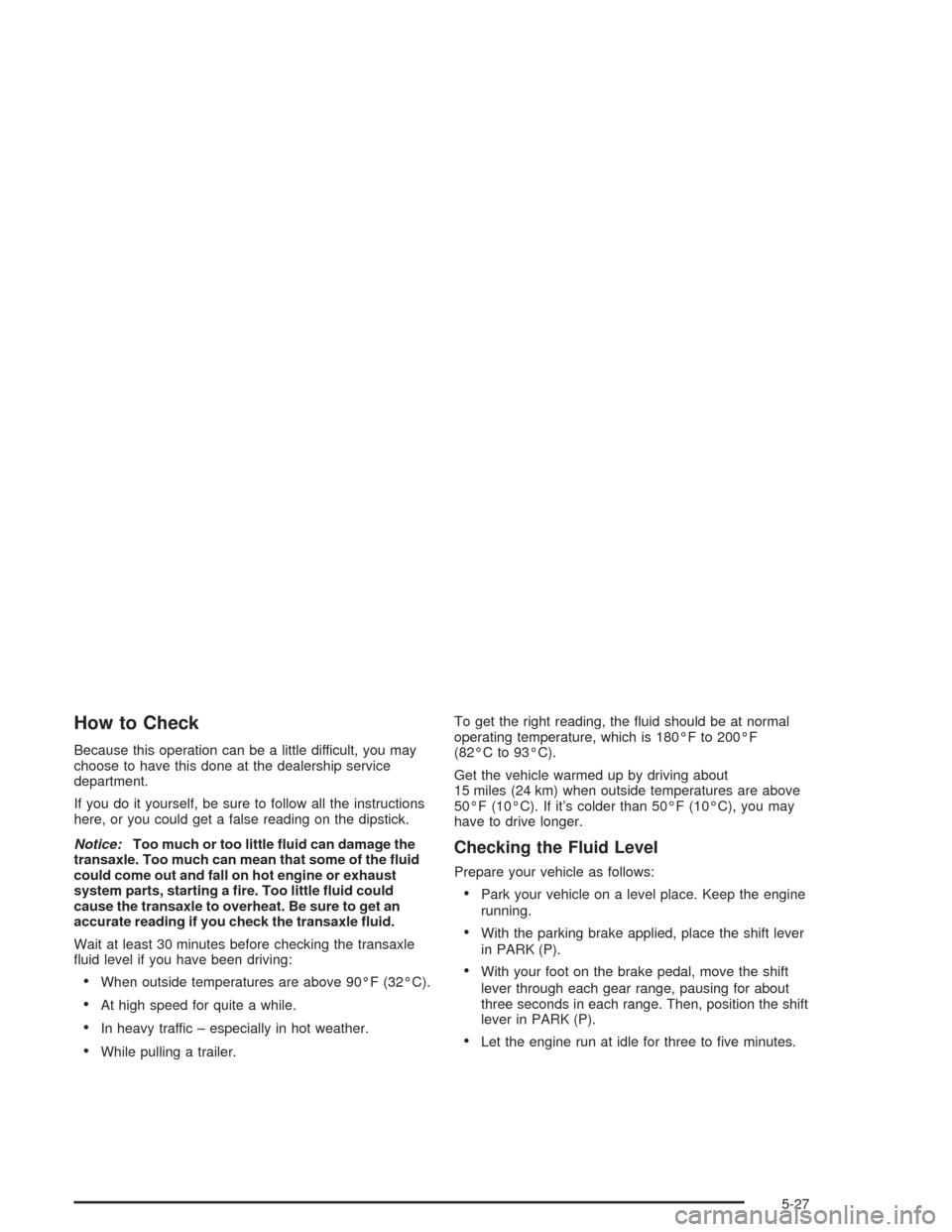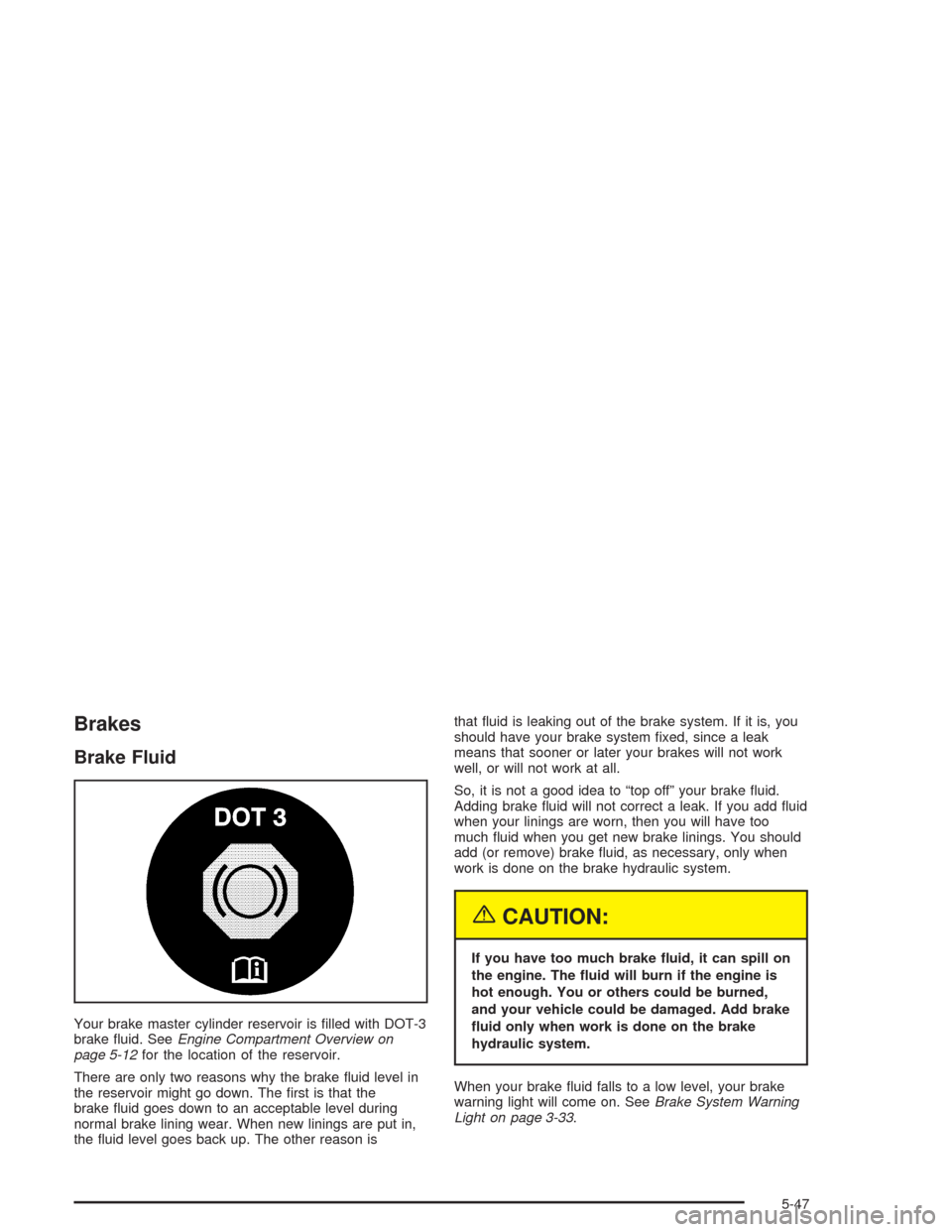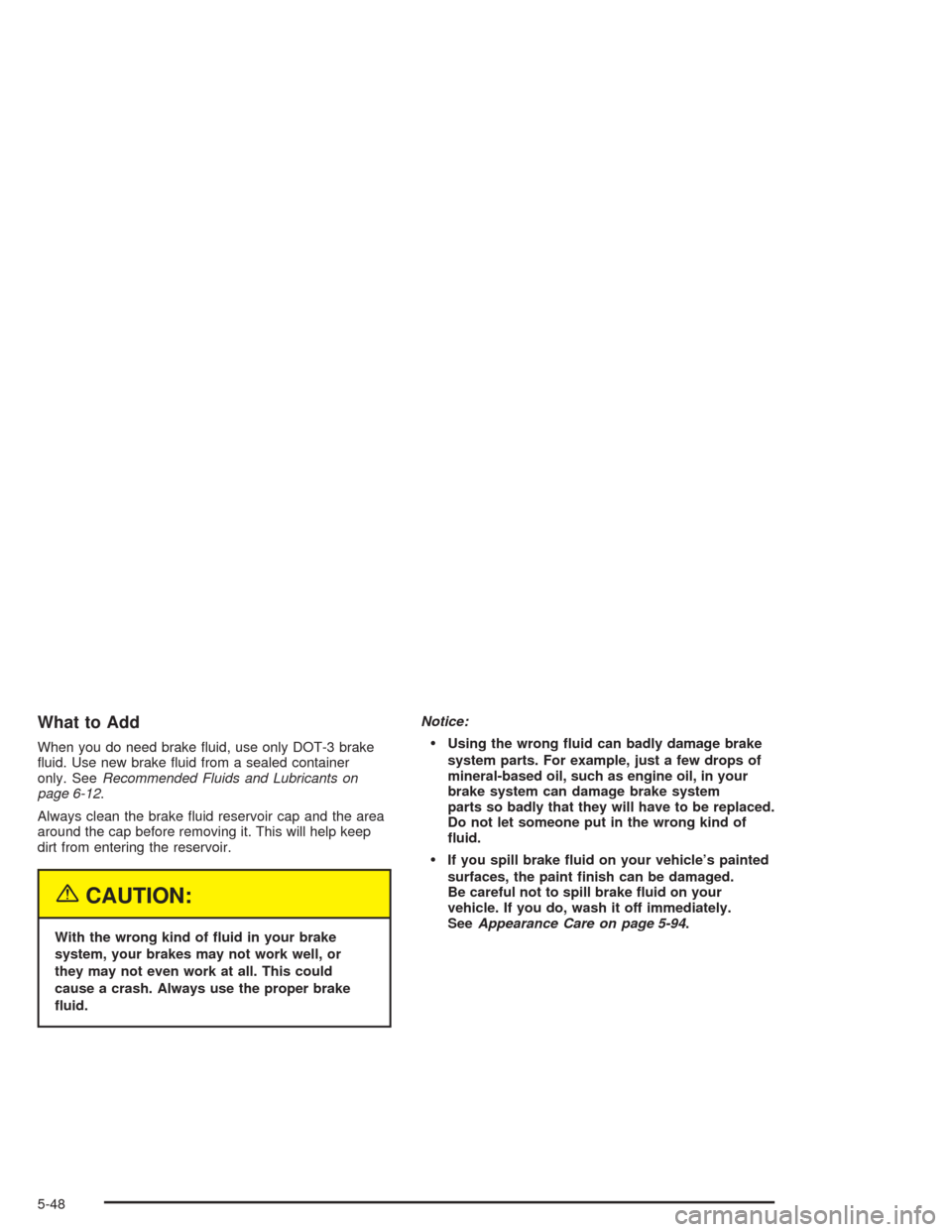Page 273 of 420
Hood Release
To open the hood, do the following:
1. Pull the handle
located inside the
vehicle near the
parking brake pedal.
2. Then go to the front of the vehicle and release the
secondary hood latch, located near the center of
the hood front, by pushing the latch to the right.
3. Lift the hood.
Before closing the hood, be sure all the �ller caps are
on properly. Then pull the hood down and close it �rmly.
5-11
Page 275 of 420

A. Windshield Washer Fluid Reservoir. SeeWindshield
Washer Fluid on page 5-46.
B. Battery. SeeBattery on page 5-50.
C. Remote Positive (+) Terminal. SeeJump Starting on
page 5-51.
D. Upper Underhood Fuse Block. See “Upperhood
Fuse Block (Upper)” underFuses and Circuit
Breakers on page 5-103.
E. Lower Underhood Fuse Block. See “Underhood
Fuse Block (Lower)” underFuses and Circuit
Breakers on page 5-103.
F. Radiator Pressure Cap. SeeRadiator Pressure Cap
on page 5-32.
G. Engine Coolant Recovery Tank. SeeCooling System
on page 5-35.
H. Power Steering Fluid Reservoir. SeePower Steering
Fluid on page 5-45.I. Electric Cooling Fan. SeeCooling System on
page 5-35.
J. Engine Oil Fill Cap. See “Checking Engine Oil”
underEngine Oil on page 5-18.
K. Engine Oil Dipstick. See “Checking Engine Oil”
underEngine Oil on page 5-18.
L. Bleed Valves (underneath engine shield).
See “How to Add Coolant to the Radiator” under
Cooling System on page 5-35.
M. Transaxle Fluid Dipstick. SeeAutomatic Transaxle
Fluid on page 5-26.
N. Brake Master Cylinder Reservoir. SeeBrakes on
page 5-47.
O. Engine Air Cleaner/Filter. SeeEngine Air
Cleaner/Filter on page 5-25.
5-13
Page 277 of 420

A. Windshield Washer Fluid Reservoir. SeeWindshield
Washer Fluid on page 5-46.
B. Battery. SeeBattery on page 5-50.
C. Remote Positive (+) Terminal. SeeJump Starting on
page 5-51.
D. Upper Underhood Fuse Block. See “Upperhood
Fuse Block (Upper)” underFuses and Circuit
Breakers on page 5-103.
E. Lower Underhood Fuse Block. See “Underhood
Fuse Block (Lower)” underFuses and Circuit
Breakers on page 5-103.
F. Radiator Pressure Cap. SeeRadiator Pressure Cap
on page 5-32.
G. Engine Coolant Recovery Tank. SeeCooling System
on page 5-35
H. Power Steering Fluid Reservoir (low in engine
compartment). SeePower Steering Fluid on
page 5-45.I. Electric Cooling Fan. SeeCooling System on
page 5-35.
J. Engine Oil Dipstick. See “Checking Engine Oil”
underEngine Oil on page 5-18.
K. Engine Oil Fill Cap. See “Checking Engine Oil”
underEngine Oil on page 5-18.
L. Bleed Valves (underneath engine shield).
See “How to Add Coolant to the Radiator” under
Cooling System on page 5-35.
M. Transaxle Fluid Dipstick. SeeAutomatic Transaxle
Fluid on page 5-26.
N. Brake Master Cylinder Reservoir. SeeBrakes on
page 5-47.
O. Engine Air Cleaner/Filter. SeeEngine Air
Cleaner/Filter on page 5-25.
5-15
Page 279 of 420
A. Windshield Washer Fluid Reservoir. SeeWindshield
Washer Fluid on page 5-46.
B. Battery. SeeBattery on page 5-50.
C. Remote Positive (+) Battery Terminal. SeeBattery
on page 5-50.
D. Underhood Electrical Center. SeeFuses and Circuit
Breakers on page 5-103.
E. Radiator Pressure Cap. SeeCooling System on
page 5-35.
F. Engine Coolant Recovery Tank. SeeCooling System
on page 5-35.
G. Power Steering Fluid Reservoir (Below Generator).
SeePower Steering Fluid on page 5-45.H. Electric Cooling Fan. SeeCooling System on
page 5-35.
I. Engine Oil Dipstick. SeeEngine Oil on page 5-18.
J. Engine Oil Fill Cap. SeeEngine Oil on page 5-18.
K. Automatic Transaxle Fluid Dipstick. SeeAutomatic
Transaxle Fluid on page 5-26.
L. Brake Fluid Reservoir. SeeAutomatic Transaxle
Fluid on page 5-26.
M. Engine Air Cleaner/Filter. SeeEngine Air
Cleaner/Filter on page 5-25.
5-17
Page 289 of 420

How to Check
Because this operation can be a little difficult, you may
choose to have this done at the dealership service
department.
If you do it yourself, be sure to follow all the instructions
here, or you could get a false reading on the dipstick.
Notice:Too much or too little �uid can damage the
transaxle. Too much can mean that some of the �uid
could come out and fall on hot engine or exhaust
system parts, starting a �re. Too little �uid could
cause the transaxle to overheat. Be sure to get an
accurate reading if you check the transaxle �uid.
Wait at least 30 minutes before checking the transaxle
�uid level if you have been driving:
When outside temperatures are above 90°F (32°C).
At high speed for quite a while.
In heavy traffic – especially in hot weather.
While pulling a trailer.To get the right reading, the �uid should be at normal
operating temperature, which is 180°F to 200°F
(82°C to 93°C).
Get the vehicle warmed up by driving about
15 miles (24 km) when outside temperatures are above
50°F (10°C). If it’s colder than 50°F (10°C), you may
have to drive longer.
Checking the Fluid Level
Prepare your vehicle as follows:
Park your vehicle on a level place. Keep the engine
running.
With the parking brake applied, place the shift lever
in PARK (P).
With your foot on the brake pedal, move the shift
lever through each gear range, pausing for about
three seconds in each range. Then, position the shift
lever in PARK (P).
Let the engine run at idle for three to �ve minutes.
5-27
Page 309 of 420

Brakes
Brake Fluid
Your brake master cylinder reservoir is �lled with DOT-3
brake �uid. SeeEngine Compartment Overview on
page 5-12for the location of the reservoir.
There are only two reasons why the brake �uid level in
the reservoir might go down. The �rst is that the
brake �uid goes down to an acceptable level during
normal brake lining wear. When new linings are put in,
the �uid level goes back up. The other reason isthat �uid is leaking out of the brake system. If it is, you
should have your brake system �xed, since a leak
means that sooner or later your brakes will not work
well, or will not work at all.
So, it is not a good idea to “top off” your brake �uid.
Adding brake �uid will not correct a leak. If you add �uid
when your linings are worn, then you will have too
much �uid when you get new brake linings. You should
add (or remove) brake �uid, as necessary, only when
work is done on the brake hydraulic system.
{CAUTION:
If you have too much brake �uid, it can spill on
the engine. The �uid will burn if the engine is
hot enough. You or others could be burned,
and your vehicle could be damaged. Add brake
�uid only when work is done on the brake
hydraulic system.
When your brake �uid falls to a low level, your brake
warning light will come on. SeeBrake System Warning
Light on page 3-33.
5-47
Page 310 of 420

What to Add
When you do need brake �uid, use only DOT-3 brake
�uid. Use new brake �uid from a sealed container
only. SeeRecommended Fluids and Lubricants on
page 6-12.
Always clean the brake �uid reservoir cap and the area
around the cap before removing it. This will help keep
dirt from entering the reservoir.
{CAUTION:
With the wrong kind of �uid in your brake
system, your brakes may not work well, or
they may not even work at all. This could
cause a crash. Always use the proper brake
�uid.Notice:
Using the wrong �uid can badly damage brake
system parts. For example, just a few drops of
mineral-based oil, such as engine oil, in your
brake system can damage brake system
parts so badly that they will have to be replaced.
Do not let someone put in the wrong kind of
�uid.
If you spill brake �uid on your vehicle’s painted
surfaces, the paint �nish can be damaged.
Be careful not to spill brake �uid on your
vehicle. If you do, wash it off immediately.
SeeAppearance Care on page 5-94.
5-48
Page 311 of 420

Brake Wear
Your vehicle has four-wheel disc brakes.
Disc brake pads have built-in wear indicators that make
a high-pitched warning sound when the brake pads
are worn and new pads are needed. The sound
may come and go or be heard all the time your vehicle
is moving (except when you are pushing on the
brake pedal �rmly).
{CAUTION:
The brake wear warning sound means that
soon your brakes will not work well. That
could lead to an accident. When you hear the
brake wear warning sound, have your vehicle
serviced.
Notice:Continuing to drive with worn-out brake
pads could result in costly brake repair.Some driving conditions or climates may cause a brake
squeal when the brakes are �rst applied or lightly
applied. This does not mean something is wrong with
your brakes.
Properly torqued wheel nuts are necessary to help
prevent brake pulsation. When tires are rotated, inspect
brake pads for wear and evenly tighten wheel nuts in
the proper sequence to GM torque speci�cations.
Brake linings should always be replaced as complete
axle sets.
Brake Pedal Travel
See your dealer if the brake pedal does not return to
normal height, or if there is a rapid increase in
pedal travel. This could be a sign of brake trouble.
Brake Adjustment
Every time you apply the brakes, with or without the
vehicle moving, your brakes adjust for wear.
5-49